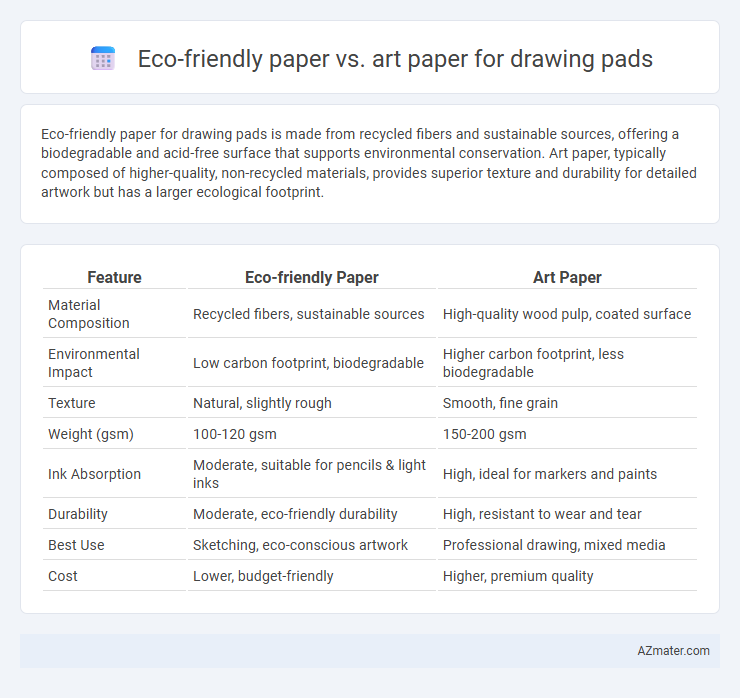Eco-friendly paper for drawing pads is made from recycled fibers and sustainable sources, offering a biodegradable and acid-free surface that supports environmental conservation. Art paper, typically composed of higher-quality, non-recycled materials, provides superior texture and durability for detailed artwork but has a larger ecological footprint.
Table of Comparison
| Feature | Eco-friendly Paper | Art Paper |
|---|---|---|
| Material Composition | Recycled fibers, sustainable sources | High-quality wood pulp, coated surface |
| Environmental Impact | Low carbon footprint, biodegradable | Higher carbon footprint, less biodegradable |
| Texture | Natural, slightly rough | Smooth, fine grain |
| Weight (gsm) | 100-120 gsm | 150-200 gsm |
| Ink Absorption | Moderate, suitable for pencils & light inks | High, ideal for markers and paints |
| Durability | Moderate, eco-friendly durability | High, resistant to wear and tear |
| Best Use | Sketching, eco-conscious artwork | Professional drawing, mixed media |
| Cost | Lower, budget-friendly | Higher, premium quality |
Introduction to Drawing Pad Paper Types
Eco-friendly paper for drawing pads emphasizes sustainability through recycled fibers and non-toxic inks, making it ideal for artists seeking environmentally responsible materials. Art paper, often crafted with higher-quality cotton or wood pulp, offers superior texture and durability suited for various drawing techniques like pencil, ink, and mixed media. Understanding the distinct composition and surface properties of eco-friendly versus art paper helps artists select the best substrate that balances environmental impact with artistic performance.
What Defines Eco-Friendly Paper?
Eco-friendly paper is defined by its sustainable sourcing, recycled content, and minimal environmental impact during production, making it a responsible choice for drawing pads. Unlike art paper, which prioritizes texture and permanence for artistic techniques, eco-friendly paper emphasizes reducing deforestation and chemical usage. This type of paper often features certifications like FSC or recycled labels, ensuring its commitment to ecological preservation.
Key Features of Art Paper for Drawing
Art paper for drawing pads features a smooth texture and high-quality weight, typically ranging from 150 to 300 gsm, allowing for precise detail and vibrant color reproduction. Its acid-free composition ensures longevity and prevents yellowing, making it ideal for archival-quality artwork. The paper's surface is specially engineered to handle various media, including graphite, charcoal, ink, and colored pencils, providing excellent durability and minimal feathering.
Environmental Impact: Eco-Friendly vs Art Paper
Eco-friendly paper drawing pads use recycled fibers and sustainable materials, significantly reducing deforestation and carbon emissions compared to traditional art paper. Art paper often involves chemical bleaching and intensive processing, contributing to greater environmental pollution and resource depletion. Choosing eco-friendly paper supports conservation efforts and promotes a smaller ecological footprint in artistic practices.
Texture and Performance Comparison
Eco-friendly paper features a natural, slightly rough texture that enhances pencil and charcoal adherence, offering excellent blending capabilities suited for sketches and mixed media. Art paper presents a smoother, more uniform surface ideal for fine detail work and vibrant ink performance, delivering sharper lines and crisp color reproduction. Both papers exhibit durable composition, but eco-friendly options emphasize sustainability with recycled fibers, while art paper often prioritizes archival quality and longevity for professional-grade artwork.
Durability and Longevity of Each Paper Type
Eco-friendly paper for drawing pads typically offers moderate durability due to its recycled fibers and minimal chemical processing, making it resistant to yellowing and environmental damage over time. Art paper, often composed of high-quality cotton or wood pulp with specialized coatings, provides superior longevity and strength, ensuring artwork remains vibrant and intact for decades. While eco-friendly paper supports sustainability, art paper excels in preserving the integrity of detailed drawings through enhanced abrasion resistance and archival properties.
Cost Analysis: Affordability of Eco-Friendly and Art Paper
Eco-friendly paper typically costs less due to sustainable production methods and recycled materials, making it a budget-friendly option for drawing pads. Art paper, often made from higher-quality fibers and specialized textures, tends to be more expensive but offers superior durability and visual appeal. Balancing cost and quality is essential for artists who seek both affordability and performance in their drawing materials.
Suitability for Different Drawing Mediums
Eco-friendly paper offers a textured surface ideal for dry mediums like graphite, charcoal, and colored pencils, enhancing grip and blending capabilities. Art paper, typically smoother and acid-free, suits wet mediums such as ink, watercolor, and markers, providing consistent absorption and preventing bleeding. Selecting between eco-friendly and art paper depends on the preferred drawing medium and desired finish, balancing environmental impact and artistic performance.
Choosing the Right Drawing Pad for Your Needs
Eco-friendly paper offers sustainable, acid-free material ideal for artists prioritizing environmental impact and durability, while art paper provides a smoother texture that enhances color vibrancy and detail precision. Choosing the right drawing pad depends on your project requirements; eco-friendly pads support mixed media and long-lasting preservation, whereas art paper excels in fine line work and watercolor effects. Consider your preferred medium and commitment to sustainability to determine which paper optimizes your artistic outcomes.
Future Trends in Sustainable Art Materials
Eco-friendly paper, made from recycled fibers and agricultural waste, is rapidly gaining traction in drawing pads due to its reduced environmental impact and biodegradable properties. Art paper, traditionally prized for texture and archival quality, is evolving with innovations such as chlorine-free processing and non-toxic coatings to meet sustainability standards. Future trends indicate a growing preference for hybrid materials that combine durability and eco-consciousness, supported by increasing demand from environmentally aware artists and industries.

Infographic: Eco-friendly paper vs Art paper for Drawing pad
 azmater.com
azmater.com